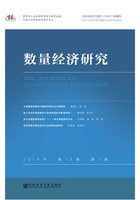
参考文献
胡飞.2016.制造业全球价值链分工的环境效应及中国的对策[J].经济问题探索,(3): 151-155.
江洪.2016.金砖国家对外贸易隐含碳的测算与比较——基于投入产出模型和结构分解的实证分析[J].资源科学,38(12):2326-2337.
赖伟娟,钟姿华.2017.中国与欧、美、日制造业全球价值链分工地位的比较研究[J].世界经济研究,(1): 125-135.
李静.2015.初始人力资本匹配、垂直专业化与产业全球价值链跃迁[J].世界经济研究,(1): 65-73.
李珊珊,罗良文.2012.FDI行业结构对中国对外贸易隐含碳排放的影响——基于指数因素分解的实证分析[J].资源科学,34(5): 855-863.
刘斌,王杰,魏倩.2015.对外直接投资与价值链参与:分工地位与升级模式[J].数量经济技术经济研究,(12): 39-56.
刘志彪,张杰.2007.全球代工体系下发展中国家俘获型网络的形成、突破与对策[J].中国工业经济,(5): 39-47.
潘安.2017.全球价值链分工对中国对外贸易隐含碳排放的影响[J].国际经贸探索,(3): 14-26.
彭水军,包群.2006.经济增长与环境污染——环境库兹涅茨曲线假说的中国检验[J].财经问题研究,(8):3-17.
彭水军,张文城,孙传旺.2015.中国生产侧和消费侧碳排放量测算及影响因素研究[J].经济研究,(1):168-182.
申萌,李凯杰,曲如晓.2012.技术进步、经济增长与二氧化碳排放:理论和经验研究[J].世界经济,(7): 83-100.
谭娟,陈鸣.2015.基于多区域投入产出模型的中欧贸易隐含碳测算及分析[J].经济学家,(2): 72-81.
王文治,陆建明.2016.中国对外贸易隐含碳排放余额的测算与责任分担[J].统计研究,8(33):12-20.
王玉燕,王建秀,阎俊爱.2015.全球价值链嵌入的节能减排双重效应——来自中国工业面板数据的经验研究[J].中国软科学,(8):148-162.
谢锐,赵果梅.2016.GMRIO模型视角下中国对外贸易环境效应研究[J].数量经济技术经济研究,(5): 84-102.
杨飞,孙文远,张松林.2017.全球价值链嵌入、技术进步与污染排放——基于中国分行业数据的实证研究[J].世界经济研究,(2): 126-134.
尹伟华.2016.中国制造业产品全球价值链的分解分析——基于世界投入产出表视角[J].世界经济研究,(1): 66-75.
张华,魏晓平.2014.绿色悖论抑或倒逼减排——环境规制对碳排放影响的双重效应[J].中国人口·资源与环境,24(9): 21-29.
郑国姣,杨来科.2015.东亚地区产业垂直专业化、贸易细分与中国的贸易隐含碳[J].产经评论,(2): 96-105.
Cole,M.A.,R.J.R.Elliott,T.Okubo.2014.International Environmental Outsourcing[J].Review of World Economics ,150(4): 639-664.
Dean,J.M.,K.C.Fung,Z.Wang.2008.Measuring the Vertical Specialization in Chinese Trade[J].US International Trade Commission Office of Economic Working Paper ,(6): 10-14.
Dong,Y.,M.Ishikawa,X.Liu.2010.An Analysis of the Driving Forces of CO2 Emissions Embodied in Japan-China Trade[J].Energy Policy ,(38): 6784-6792.
Du,H.,J.Guo,G.Mao,A.M.Smith,X.Wang,Y.Wang.2011.CO2 Emissions Embodied in China-US Trade: Input-Output Analysis Based on Energy/Dollar Ratio[J]. Energy Policy ,39(10): 5980-5987.
Gereffi,G.2001.Beyond the Producer-driven/Buyer-driven Dichotomy the Evolution of Global Value Chains in the Era[J].IDS Bulletin ,32(3): 30-40.
Gereffi,G.,X.Luo.2014.Risks and Opportunities of Participation in Global Value Chains[R].World Bank Policy Research Working Paper ,No.6847.
Glachant,M.,D.Dussaux,Y.Meniere,et al.2013.Greening Global Value Chains: Innovation and the International Diffusion of Technologies and Knowledge[R].The World Bank Policy Research Working Paper ,No.6467.
Grossman,G.M.,A.B.Kruger.1991.Environmental Impacts of the North American Free Trade Agreement[R].NBER Working Paper .
Hummels,D.,J.Ishii,K.M.Yi.2011.The Nature and Growth of Vertical Specialization in World Trade[J].Journal of International Economics ,54(1): 75-96.
Humphrey,J.,H.Schmitz.2002.How Does Insertion in Global Value Chains Affect Upgrading in Industrial Clusters[J].Regional Studies ,36(9): 1017-1027.
Koopman,R.,W.Powers,Z.Wang,S.J.Wei.2010.Give Credit Where Credit Is Due: Tracing Value Added in Global Production Chains[J].National Bureau of Economic Research .
Kuznets,S.1995.Economic Growth and Income Inequality[J].American Economic Review, 49(1): 1-28.
Lin,B.Q.,C.W.Sun.2010.Evaluating Carbon Dioxide Emissions in International Trade of China[J].Energy Policy ,38(1): 613-621.
Minx,J.,T.Wiedmann,J.Barrett.2008.Allocating Ecological Footprints to Final Consumption Categories with Input-Output Analysis[J].Energy Policy ,25(1): 245-258.
Schmitz,H.2004.Local Upgrading in Global Chains: Recent Findings[R].Paper to Be Presented at the DRUID Summer Conference .
Sinn,H.W.2008.Public Policies Against Global Warming: A Supply Side Approach[J].International Tax Public Finance ,15: 360-394.
Wang,Z.,S.J.Wei,K.F.Zhu.2013.Quantifying International Production Sharing at the Bilateral and Sector Level[R].NBER Working Papers ,No.19677.
Weitzel,M.,T.Ma.2014.Emission Embodied in Chinese Exports Taking into Account the Special Export Structure of China[J].Energy Economics ,(45): 45-52.
Xu,Y.,E.Dietzenbacher.2014.A Structural Decomposition Analysis of the Emissions Embodied in Trade[J].Ecological Economics ,101:10-20.
Zhao,Y.H.,Z.H.Zhang,S.Wang.2014.CO2 Emission Embodied in China's Foreign Trade: An Investigation from the Perspective of Global Vertical Specialization[J].China & World Economy ,22(4): 102-120.
[1][基金项目]本文受到国家自然科学基金项目“基于知识溢出的区域技术创新驱动与产业结构优化升级耦联机制研究”(71473109)、国家自然科学基金项目“区际产业梯度转移与升级中的技术势能集聚、转换及空间效应研究”(71773041)、国家自然科学基金项目“基于双边环境约束的对外直接投资对母国绿色技术创新的作用机制”(71763010)的联合资助。
[2][作者简介] 陶长琪(1967-),男,江西财经大学统计学院教授,博士生导师,主要研究方向为数量经济学。徐志琴(1994-),女,江西财经大学数量经济学专业硕士研究生,主要研究方向为数量经济学。